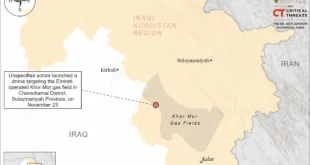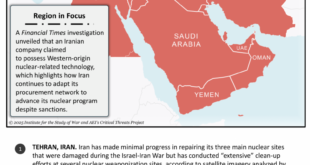Armenian and Azerbaijani forces continue to exchange fire in and around the breakaway Nagorno-Karabakh region despite international calls for both sides to implement and stick to a Russian-brokered humanitarian cease-fire.
Azerbaijan’s Defense Ministry said on October 13 that the situation in several sectors of the conflict zone remained tense overnight, and accused Armenian armed forces of shelling the Tartar district in the morning.
The Armenian Defense Ministry denied the accusation, in turn claiming that the Azerbaijani side “resumed its actions, accompanied by active rocket and artillery fire, in the southern, northern, and northeastern” sectors of the front line.
However, an Azerbaijani Defense Ministry spokesman insisted that the country’s military “is not delivering any strikes and is not launching any offensive,” and is “fully complying with the humanitarian cease-fire.”
The cease-fire agreement reached in Moscow on October 10 was meant to allow ethnic Armenian forces and Azerbaijan to swap prisoners and bodies of hundreds of soldiers and civilians killed during two weeks of fighting.
However, the International Committee of the Red Cross (ICRC) on October 13 said Armenia and Azerbaijan had yet to finalize arrangements for it to handle a prisoner swap and an exchange of corpses as envisaged by the deal.
“To date, we keep discussing intensely with the sides on this topic. But no meaningful agreement has been reached yet that will allow us to actually proceed to such an exchange,” Martin Schuepp, ICRC Eurasia regional director, told a news briefing in Geneva.
The fighting broke out in and around the breakaway region on September 27 — the biggest escalation in the conflict over Nagorno-Karabakh since a shaky 1994 cease-fire.
Nagorno-Karabakh is internationally recognized as part of Azerbaijan but governed and populated by ethnic Armenians.
The truce agreement also envisages a relaunch of peace talks to be mediated by the Minsk Group, which was set up in the 1990s under the auspices of the Organization for Security and Cooperation in Europe (OSCE) to mediate the conflict.
The deal says the existing format of negotiations will remain in place and will not be changed over time.
The Minsk Group is co-chaired by France, Russia, and the United States, which on October 13 called on Azerbaijan and Armenia to “implement their commitments to a cease-fire as agreed and cease targeting civilian areas.”
“We deplore the loss of human life and remain committed to a peaceful settlement” of the conflict over Nagorno-Karabakh, U.S. Secretary of State Mike Pompeo tweeted.
As fighting continued unabated, Russian Foreign Minister Sergei Lavrov hosted Armenian Foreign Minister Zohrab Mnatsakanian in Moscow on October 12.
“We expect that the decisions that have been adopted will be rigorously observed by both parties,” Lavrov said after the talks, adding that work was underway to put in place mechanisms to monitor the observance of the cease-fire.
Mnatsakanian said the Armenians “want the cease-fire, we want verification mechanisms on the ground.”
Also in Moscow, Russian Deputy Foreign Minister Andrei Rudenko met with the U.S. Minsk Group co-chair to discuss “possible steps” to implement the cease-fire agreement reached on October 10, according to Russia’s Foreign Ministry.
The ministry said the meeting was attended by Andrzej Kasprzyk, the personal representative of the OSCE chairperson-in-office for Nagorno-Karabakh.
In Paris, French Foreign Ministry spokeswoman Agnes von der Muhll said it was “indispensable and urgent” that the truce was “strictly” obeyed.
The ongoing fighting has increased concern that a wider conflict could drag in regional power Turkey, which is Azerbaijan’s closest ally, and Russia, which has a defense pact with Armenia.
Mnatsakanian accused Azerbaijan of acting to expand Turkey’s influence in the region and of using mercenaries in the conflict — allegations both Ankara and Baku have rejected.
Russian Defense Minister Sergei Shoigu on October 12 held a telephone conversation with his Turkish counterpart, Hulusi Akar, during which he expressed concerns “about incoming information concerning the redeployment of terrorist fighters from the Middle East to the Nagorno-Karabakh conflict zone,” according to Russia’s Defense Ministry.
A statement released by Turkey quoted Akar as telling Shoigu that Ankara supported Azerbaijan’s offensive to “retake its occupied lands.”
“Baku will not wait another 30 years for a solution,” he said.
The same day, Azerbaijani President Ilham Aliyev reiterated calls for Ankara to be involved in the international mediation of the conflict, saying, “Even if many Western countries do not want to accept it, Turkey’s word is big, it’s fully independent.”
In neighboring Iran, the deputy governor of Ardebil Province said an unidentified drone had crashed near the border with Azerbaijan on October 13.
Behrouz Nedayi told state news agency IRNA that the incident took place in a village in Parsabad county, adding that no damage was reported.
He added that the drone’s identity and cause of its crash” are being investigated and that it “may belong to Azerbaijan or Armenia’s army given the fighting beyond Iran’s northern border.”
Nagorno-Karabakh is recognized internationally as part of Azerbaijan. But it has been under the control of Yerevan-backed ethnic Armenian forces since a 1994 cease-fire brought an end to the separatist war that broke out as the Soviet Union collapsed.
Since then, Nagorno-Karabakh has been populated and governed by ethnic Armenians, leaving hundreds of thousands of Azerbaijanis from the region as internally displaced war refugees in Baku and other parts of Azerbaijan for more than a quarter-century.
 Eurasia Press & News
Eurasia Press & News


